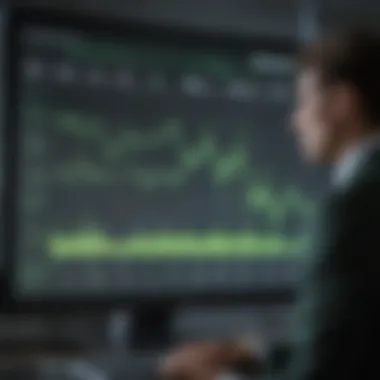Sberbank Share Price Dynamics: In-Depth Analysis


Intro
In recent years, Sberbank has emerged as a key player in the Russian banking sector and its share price dynamics offer important insights for investors. The fluctuations in Sberbank's stock price are influenced by various internal and external factors, including economic conditions, regulatory changes, and market sentiment. Understanding these dynamics is essential for making informed investment decisions. This article provides a comprehensive overview of Sberbank's share price trends and the elements that drive them.
Market Overview
Current Market Trends
Sberbank's share price is closely tied to the overall market conditions in Russia. Recent trends show a significant correlation between the bank's stock performance and external economic indicators. The bank has demonstrated resilience amid fluctuating economic conditions, but investors must remain vigilant about ongoing geopolitical tensions, as these can manifest in share price volatility.
Key Market Indices Performance
Monitoring key indices like the Moscow Exchange Index can offer valuable insights into Sberbank's performance. For instance, if the index trends upwards, it generally bolsters investor confidence. Consequently, Sberbank's stocks often follow suit, benefiting from the overall positive sentiment in the market.
Economic Factors Influencing the Market
Several economic factors can directly affect Sberbank's share price. These include interest rate changes, inflation rates, and currency fluctuations. For example, rising interest rates typically enhance bank profitability, which can boost the stock price. Conversely, high inflation can erode purchasing power, impacting consumer spending and loan demand.
Sector Spotlight: Leading Sectors Affected by Trend
In the context of Sberbank, sectors such as technology and finance often drive market sentiment. The boom in technology has started reshaping consumer banking experiences. Innovations in fintech may consequently influence Sberbank’s strategic positioning in the market as it looks to enhance its digital infrastructure. Monitoring these sectors can provide a broader perspective on potential risks and opportunities.
Stocks in Focus
High-Performance Stocks: Analysis and Recommendations
Sberbank remains a high-performance stock, especially when compared to its peers. The bank's solid fundamentals have made it a preferred choice for investors looking for stability. Analyzing its price-to-earnings ratio may reveal further insights into its valuation compared to competitors like VTB Bank or Gazprombank.
Undervalued Stocks: Opportunities for Investment
Identifying undervalued stocks can yield significant returns. Potential investors might assess Sberbank’s recent decline in stock price and evaluate whether the fundamentals support a more attractive investment entry point.
Emergent Stocks: Innovations and Market Entry
Sberbank is not just a traditional bank; it is also investing in startups and emerging technologies. This diversification may provide unique opportunities for growth. Keeping tabs on these emergent stocks within the Sberbank portfolio could yield rewards for risk-tolerant investors.
Investment Strategies
Short-Term vs Long-Term Investment Approaches
When investing in Sberbank, different strategies could apply. Short-term investors may capitalize on market volatility, while long-term investors should focus on the bank's fundamentals and broader economic trends.
Risk Management Techniques
Investors must exercise caution. Techniques such as setting stop-loss orders can help manage risks. Understanding your risk threshold is crucial when dealing with financial stocks like Sberbank.
Diversification: Building a Balanced Portfolio
Building a diversified portfolio may mitigate risks. By spreading investments across various sectors, including Sberbank, an investor can balance potential losses.
Value Investing vs Growth Investing
Value investing focuses on undervalued stocks, while growth investing seeks stocks with high potential. Sberbank may fit both categories depending on market conditions and investor perspectives.
Tools & Resources for Investors
Interactive Stock Charts and Tools
Utilizing interactive charts can provide real-time data on Sberbank's stock movements. Such tools are invaluable for making timely investment decisions.
Calculators: Investment, Retirement, and Profit


Financial calculators can aid in making long-term investment plans and help assess potential returns on investments.
Educational Resources: Articles, and Tutorials
Several platforms offer educational resources that explain market dynamics and investment strategies tailored for beginner and experienced investors alike.
Market Analysis Reports: What to Look For
Identifying credible market analysis reports can provide key insights into Sberbank’s performance and future outlook. Trusted publications often present detailed metrics and projections relevant to investor interests.
Personalized Investment Planning
Assessing Personal Financial Goals
Before investing in Sberbank or any other stock, assessing your financial goals is essential. Determine how much risk you can take and what financial milestones you aim to achieve.
Creating a Tailored Investment Strategy
A tailored investment strategy should align with personal goals and risk tolerance. Understanding your investment horizon is crucial when considering stocks like Sberbank.
Regular Portfolio Reviews
Regular portfolio reviews can help adjust strategies in response to market changes. Staying informed on Sberbank's performance allows for proactive decision-making.
Consulting Services: When to Seek Professional Help
For those uncertain about their investment approach, consulting a financial advisor might provide clarity. Professional advice ensures that investment strategies align with individual goals and market conditions.
Investment in Sberbank requires careful analysis of market trends, personal financial goals, and informed strategies.
Prologue to Sberbank Share Price
Understanding the dynamics of Sberbank's share price is essential for various stakeholders, ranging from retail investors to institutional entities. This section offers a foundational insight into how the price of Sberbank shares is influenced by multiple factors. This understanding is essential for informed decision-making, highlighting trends that may correlate with economic conditions and geopolitical events.
Understanding Sberbank
Sberbank is one of the largest banks in Russia, with a pivotal role in the country's financial landscape. Established in 1841, it has evolved into a modern financial institution offering a wide range of services, including personal banking, corporate banking, and investment banking. The bank is state-backed, which adds a layer of stability and trust in a volatile market setting.
The significance of Sberbank extends beyond its immediate banking activities. It serves as a barometer for the Russian economy itself. Understanding its operational strategies, customer base, and priority sectors is pivotal for analyzing its share price movements. Investors often look at Sberbank as a reflection of the broader economic sentiments in Russia and the impact of international relations on local markets.
Historical Overview of Share Price Trends
When assessing Sberbank's share price, delving into historical data provides vital context for current valuations. Over the years, Sberbank’s share price has exhibited considerable volatility, influenced by economic reforms, international sanctions, and domestic financial policies.
In the early 2010s, Sberbank’s shares experienced a robust upsurge, fueled by economic growth and increased consumer spending in Russia. However, the annexation of Crimea in 2014 and subsequent sanctions led to sharp declines in share values.
More recently, the share price has shown resilience amid geopolitical tensions and fluctuating oil prices, which are crucial to the Russian economy. Analyzing key historical events alongside price trends reveals patterns that investors can consider when making investment decisions. This analysis aids in understanding not only the past fluctuations but also potential future movements.
Understanding historical trends is vital for projecting future performance. Investors should emphasize empirical data to guide their strategies.
In summary, grasping the dynamics of Sberbank’s share price is not merely a function of looking at numbers but involves understanding the broader implications of economic shifts, policy changes, and international relations. This comprehensive overview lays the groundwork for analyzing the essential factors that will be explored in greater depth in the following sections.
Factors Affecting Sberbank's Share Price
Understanding the factors that influence Sberbank's share price is crucial for investors seeking to navigate the complexities of the financial market. These factors can broadly range from economic indicators to geopolitical shifts. Each element can lead to fluctuations in share price, impacting investment decisions. Thus, having a comprehensive grasp of these determinants helps investors make informed choices and strategize better.
Economic Indicators and Their Impact
Economic indicators play a vital role in shaping Sberbank's share price. Metrics such as GDP growth, inflation rates, and employment figures are closely monitored. For instance, if the Russian economy is experiencing robust growth, it usually bodes well for Sberbank's financial performance. Good economic health increases consumer confidence, leading to higher lending activity. Conversely, high inflation or unemployment rates can negatively impact the bank's operations, leading to a decline in share price.
Additionally, investor sentiment often correlates with these indicators. Positive reports can trigger investment inflows, while negative data may incite panic, driving prices down. This relationship highlights the importance of staying updated with economic news and data releases.


Geopolitical Influences
Sberbank operates not just within the Russian market, but also faces considerable geopolitical pressures. Developments such as international sanctions or changes in foreign relations can drastically impact its share price. For example, sanctions imposed by Western nations have historically affected Sberbank’s access to international capital markets. If relations with major economies improve, the bank could see a positive impact on its share price due to increased investor confidence.
Furthermore, internal politics can also serve as a variable. Changes in government policies that favor or restrict banking operations can affect operational efficiencies and profitability, creating fluctuations in stock performance.
Central Bank Policies
The Central Bank of Russia plays a pivotal role in determining interest rates, which directly affects Sberbank’s lending processes. When the Central Bank adjusts its key rate, it alters borrowing costs for consumers and businesses alike. A reduction in interest rates can spur demand for loans, benefiting Sberbank by increasing its revenues. However, rising interest rates may have the opposite effect, discouraging borrowing and impacting profit margins.
Moreover, quantitative easing or tightening policies can influence market liquidity. An over-supply of money can drive up asset prices, including Sberbank shares, while contractionary measures may lead to reduced valuations. Therefore, understanding the Central Bank's stance is essential for anticipating potential movements in Sberbank’s stock price.
Sector-specific Dynamics
Sberbank's performance is also linked to the broader trends within the banking sector and the Russian economy. Changes in regulatory frameworks concerning the banking industry could have profound implications on operational costs and competitive positioning. For instance, stringent regulations may reduce profitability, impacting share price.
Additionally, technological advancements within the sector are transforming traditional banking practices. Adoption of fintech solutions can enhance efficiency and customer engagement, affecting overall performance. Investors should pay attention to how Sberbank adapts to these changes as they can influence its market valuation.
Staying informed about the sector-specific dynamics is essential for any investor looking to understand Sberbank's share price movements and future potential.
Through knowledge of these factors, investors can equip themselves with insights essential for making educated investment decisions regarding Sberbank. This comprehensive understanding fosters a proactive approach to portfolio management, ensuring alignment with market shifts.
Current Market Analysis
Understanding the current market dynamics is essential for investors who aim to grasp the complexities of Sberbank's share price movements. This section will provide crucial insights into recent trends, trading behavior, and comparisons with industry peers. Recognizing these elements will enhance the ability to make informed decisions in an often-volatile market.
Recent Price Movements
In the last few months, Sberbank's share price has exhibited notable fluctuations. Factors such as macroeconomic conditions, investor sentiment, and geopolitical events have all played a role in shaping these movements. For instance, the recent increase in interest rates by the Central Bank of Russia has had a direct influence on the bank's share performance. Investors often react to these shifts, leading to price volatility.
Over the past quarter, Sberbank's shares have recovered from previous declines, with the price rising significantly. A combination of strong quarterly earnings and positive forecasts from analysts contributed to this upward movement. Nonetheless, the market remains sensitive to external influences, such as global commodity prices and currency fluctuations, which can quickly reverse these gains.
Volume Trends and Trading Patterns
Analyzing volume trends is critical for understanding market sentiment. For Sberbank, trading volume has surged following significant announcements and economic indicators. Higher volumes often indicate increased interest from investors and may signal potential price movements.
Recent trends show that trading volume frequently peaks during earnings releases or when there are major policy announcements impacting the financial sector. The consistency of volume patterns can provide insights into where the market may be heading. For Sberbank, a consistent increase in trading volume typically precedes price rallies, which investors need to monitor closely.
Comparative Analysis with Peers
In the context of the banking sector, Sberbank's performance can be contrasted with its competitors, such as VTB Bank and Gazprombank. Comparative analysis involves examining key financial metrics, such as price-to-earnings ratios, return on equity, and dividend yields.
While Sberbank often leads in several performance metrics, fluctuations among its peers offer context for its market positioning. For instance, if VTB Bank reports stronger growth or more attractive valuations, investors might reassess their positions in Sberbank. As a result, a comprehensive understanding of Sberbank in relation to its competitors is vital for making well-rounded investment decisions.
Key Takeaway: Keeping track of current market analysis allows investors to navigate the complexities of Sberbank's share price dynamics effectively. By observing recent movements, volume trends, and comparative metrics, one gains critical insights for future strategies and decisions.
Future Outlook for Sberbank Share Price
The future outlook for Sberbank's share price holds critical importance as it provides insight into potential investment opportunities. It is essential to analyze both prevailing trends and underlying factors that support the long-term performance of the bank. Each investor, whether novice or experienced, seeks reasoned forecasts to make informed decisions about their portfolio.
Understanding future dynamics can be beneficial for several reasons:
- Investment Planning: Investors can tailor their strategies based on expected performance, optimizing allocation and managing risk.
- Market Positioning: Anticipating how Sberbank will perform compared to its peers can guide decisions in a volatile market.
- Economic Context: Sberbank's role in the Russian economy influences industry sectors, making projections relevant for broader economic assessments.
Long-term Projections
Long-term projections for Sberbank's share price take into account various elements such as historical trends, economic conditions, and ongoing developments in the banking sector. Analysts often review financial statements, looking at profitability, revenue growth, and cost control measures. Additionally, macroeconomic indicators like inflation and interest rates play a significant role in shaping these projections.
Over the next few years, we may expect:
- Continued growth in digital banking initiatives that enhance customer experience and operational efficiency.
- Stringent regulatory frameworks that could impact growth but could also stabilize the banking sector.
- Potential fluctuations due to geopolitical tensions, which may affect market perception and investor confidence.


According to various reports, the consensus is cautiously optimistic. Experts predict a moderate growth rate in share prices, supported by effective management strategies and a focus on innovation.
Analyst Ratings and Expectations
Analyst ratings provide an essential perspective on anticipated share price movements for Sberbank. These ratings typically derive from detailed financial modeling, competitive analysis, and consideration of economic environments. Analysts assess a wide range of indicators, including valuation metrics such as the price-to-earnings ratio and dividend yield.
Recently, several financial institutions have provided ratings based on their independent evaluations. Notable insights suggest:
- Buy Ratings: Some analysts believe there is substantial upside potential, especially as Sberbank diversifies its portfolio and embraces technology.
- Hold Ratings: Other analysts suggest a wait-and-see approach, citing factors like fluctuating interest rates and potential regulatory challenges.
- Sell Ratings: A small number express concerns regarding high-risk exposure in current geopolitical climates.
Investment Strategies Involving Sberbank
Investment strategies concerning Sberbank are essential because they provide a structured approach for investors aiming to navigate the complexities of the banking sector in Russia. Understanding the nuances of Sberbank can lead to informed decisions that align with individual financial goals. Specific elements and benefits of investing in Sberbank include its market position, stability, and potential for growth.
Value Investing Considerations
Value investing is a strategy focusing on buying shares that appear undervalued. For Sberbank, key considerations include its historical performance, dividend yield, and price-to-earnings ratio. Analyzing these metrics helps investors identify potential for capital appreciation. Additionally, considering the bank's role in the Russian economy is crucial. Sberbank's size offers a level of protection in turbulent markets, making it a favorable option for value-driven portfolios.
Risk Assessment and Management
Investment in Sberbank entails inherent risks that should not be overlooked. Key risks include:
- Market volatility: Fluctuations in the Russian stock market can impact share prices.
- Geopolitical factors: Changes in international relations can create uncertainty for investors.
- regulatory changes: Government policies may affect Sberbank's operations and profitability.
Managing these risks involves setting a clear investment strategy and regularly reviewing the market landscape. Tools such as stop-loss orders can help mitigate potential losses. Furthermore, keeping abreast of economic indicators that affect Sberbank can guide timely decisions.
Portfolio Diversification
Diversification is an important aspect of any investment strategy. When investing in Sberbank, it is vital to consider how it fits within a larger portfolio. Including Sberbank can provide exposure to the financial sector while balancing investments in different industries.
Benefits of diversification include:
- Reduction of risk: Spreading investments across various sectors decreases the impact of a poor-performing asset.
- Stability: A well-diversified portfolio can offer more consistent returns over time.
- Enhanced potential for growth: Different sectors often perform differently under varying economic conditions, increasing the opportunity for returns.
Sberbank's Role in the Russian Economy
Sberbank plays a critical role in the Russian economy. It operates not just as a financial institution but also as a key player in economic stability. The bank's actions and policies can significantly affect various sectors of the economy. This section elaborates on Sberbank's contributions to overall banking sector stability and its support for medium and small enterprises.
Contribution to Banking Sector Stability
Sberbank is the largest bank in Russia, holding a substantial share of the country's banking assets. Its size gives it a unique position to influence the market positively. It provides necessary liquidity to other banks and helps maintain confidence within the financial system.
- Stability: By managing a significant portion of deposits, Sberbank stabilizes the banking sector. This reduces the risk of bank runs and promotes trust in the financial system.
- Support During Crises: Historical events, like the 2014 economic crisis and subsequent sanctions, show how Sberbank's intervention helped stabilize the economy. It repurposed funds to support other sectors, mitigating broader economic shocks.
- Policy Implementation: Sberbank often implements the central bank's policies. This can lead to better compliance with regulations and help in maintaining system-wide stability.
“A robust banking sector is vital for economic growth and Sberbank is at the heart of this system.”
In summary, Sberbank's contribution to banking stability is essential. It not only supports trust among consumers but also helps reinforce the overall economic framework of Russia.
Support for Medium and Small Enterprises
In Russia, medium and small enterprises (SMEs) are vital for economic growth and employment. Sberbank recognizes this importance and actively supports these businesses.
- Loans and Credit Facilities: Sberbank provides a range of loan products tailored to meet the needs of SMEs. This includes favorable interest rates and flexible repayment terms.
- Advisory Services: Beyond financial products, Sberbank offers advisory services to help SMEs navigate market challenges. This is crucial for businesses that might lack experience in certain areas.
- Investment in Technology: The bank has invested in digital solutions. These tools can help SMEs streamline operations, reduce costs, and improve competitiveness in a rapidly changing market.
Sberbank’s support for medium and small enterprises is a testament to its commitment to the economy's growth. By fostering this crucial segment, it aids in job creation and innovation throughout the country.
End
In this section, we summarize the key insights derived from our exploration of Sberbank’s share price dynamics. Understanding the factors that influence Sberbank’s share price is vital for both novice and seasoned investors. This knowledge enhances decision-making and investment strategies in the dynamic landscape of the stock market.
Investors must consider economic indicators and geopolitical influences, as these elements can directly impact stock performance. Central bank policies and sector-specific dynamics also play crucial roles. By grasping these components, investors gain a more nuanced view of the market, which is essential for anticipating future price movements.
Furthermore, investment strategies formulated around Sberbank should not overlook risk assessment and portfolio diversification. A comprehensive understanding of these factors can lead to more resilient investment portfolios.
“Knowledge is power in investment. The more you know about dynamics at play, the better equipped you are to make informed decisions.”
As we conclude, it is evident that analyzing Sberbank’s share price entails a multifaceted approach that encompasses current trends, market forces, and future projections. Engaging with this information not only contributes to a solid understanding of the banking sector in Russia but also supports strategic investment planning.







